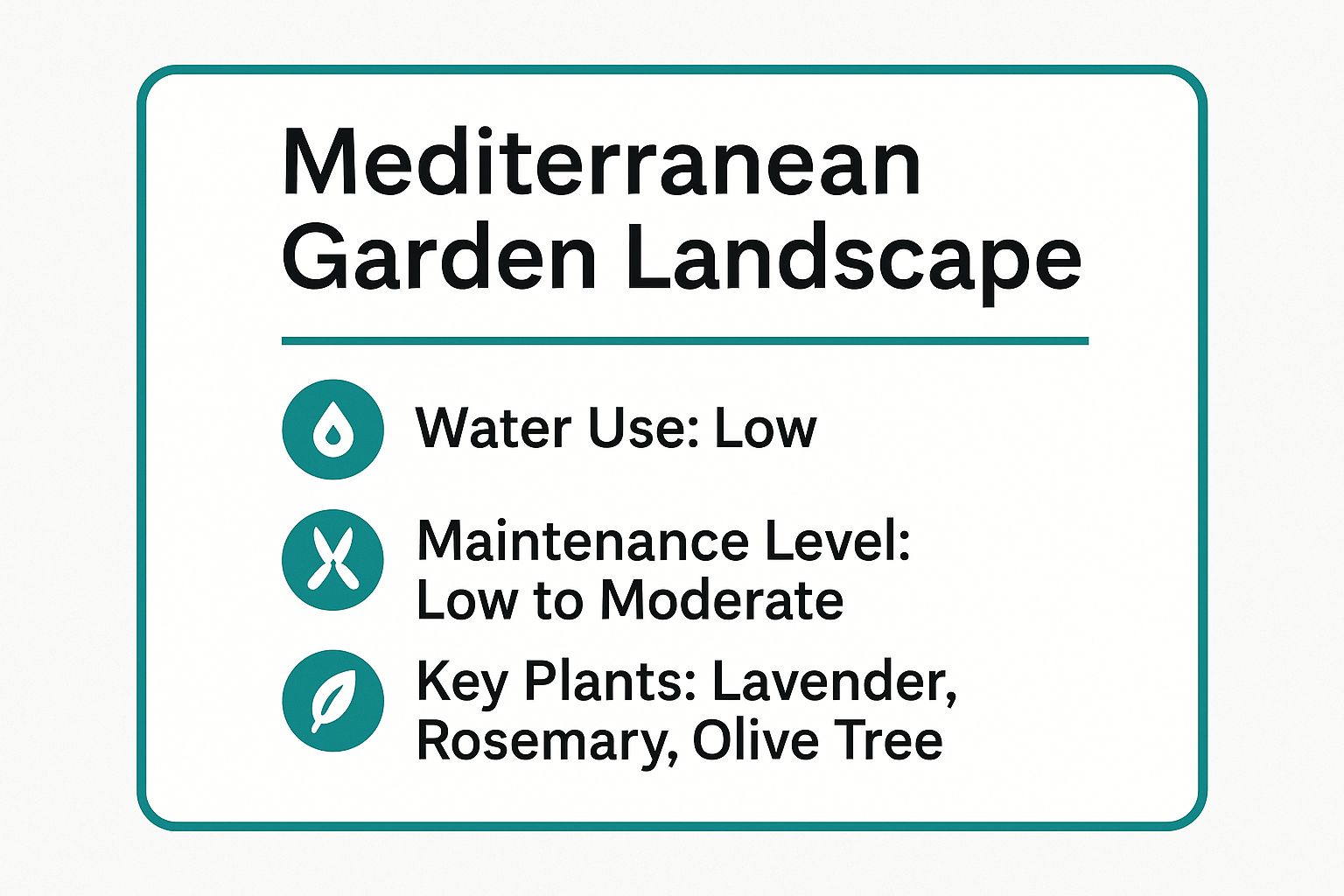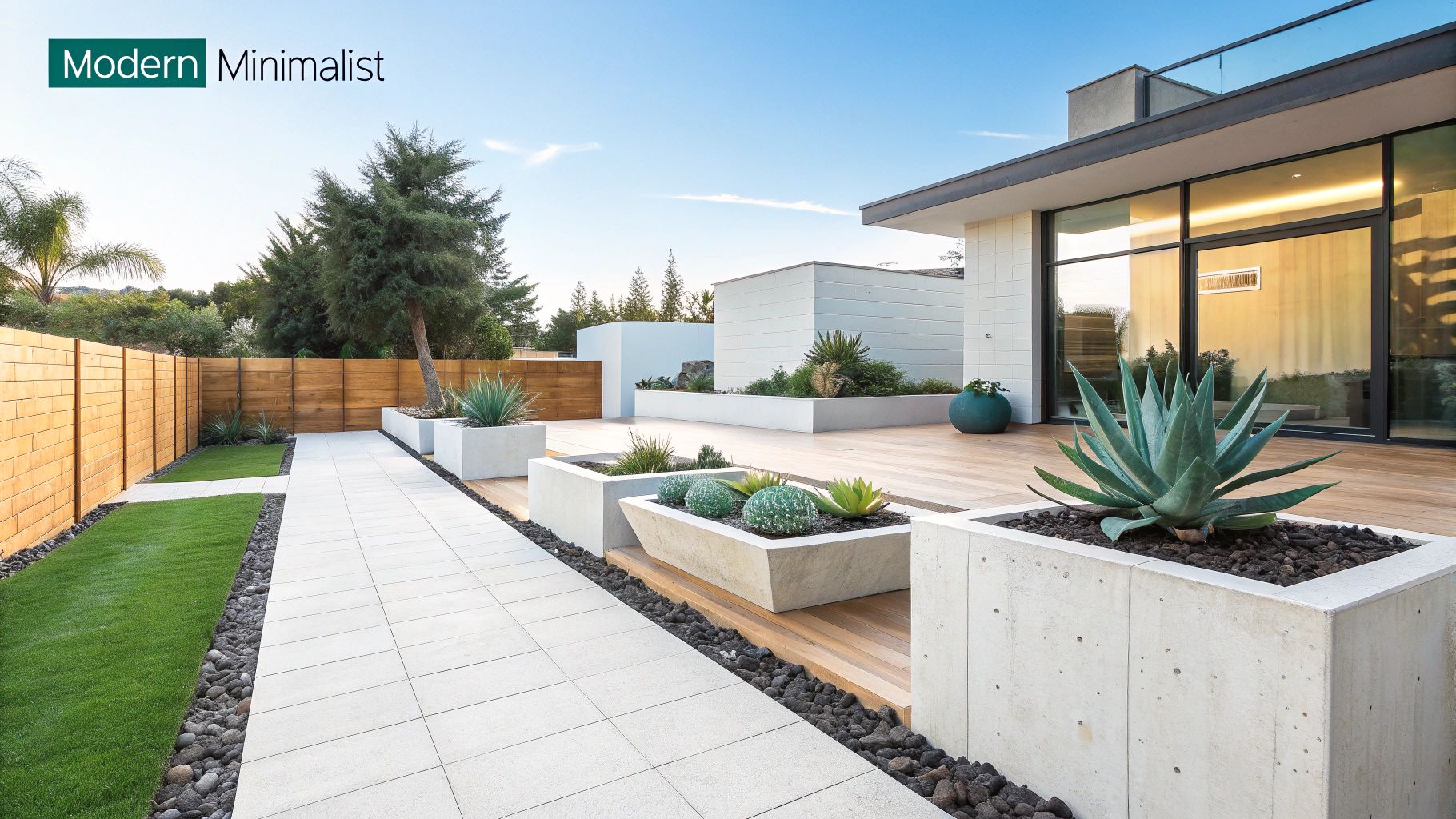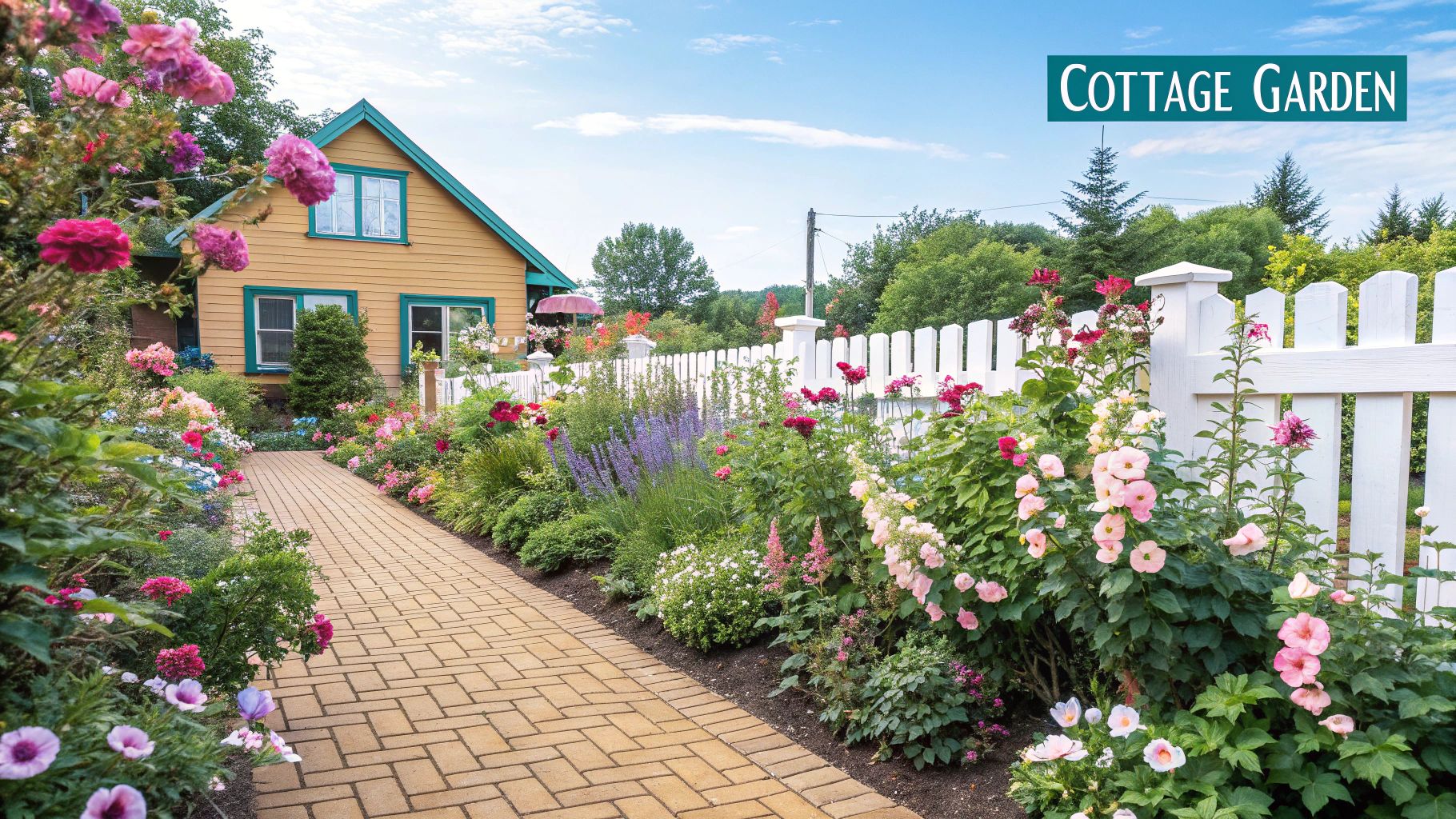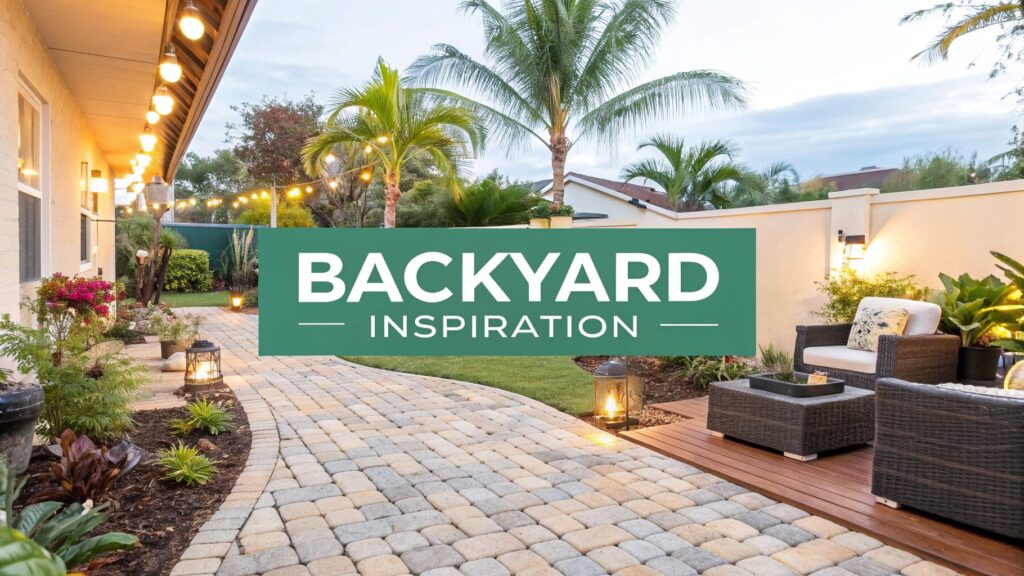Your Boca Raton backyard is more than just an outdoor area; it's a canvas awaiting transformation. Whether you're a homeowner with a sprawling lawn or a renter with a small patio, the right design can turn any space into a personal oasis. This guide moves beyond generic inspiration by providing a strategic breakdown of diverse landscaping styles, complete with actionable takeaways you can implement immediately. We will dissect a variety of backyard landscaping pictures to reveal the core principles that make each design work, from Mediterranean gardens to modern minimalist layouts.
Our goal is to equip you with a practical blueprint for creating a functional and beautiful outdoor living area that thrives in South Florida's unique climate. We'll explore specific plant choices, material selections, and layout strategies tailored to each aesthetic. For foundational elements in your landscaping blueprint, exploring stunning stone paver patio ideas can provide the perfect starting point for your outdoor design.
This article will analyze seven distinct landscaping concepts, including:
- The lush, vibrant Tropical Paradise.
- The water-wise Desert Xerophyte style.
- The serene and structured Zen Japanese Garden.
Each example includes a deep analysis and replicable methods, ensuring you have the insights needed to start your project with confidence, regardless of your budget or space constraints. Let's dive into the pictures and strategies that will redefine your outdoor space.
1. Mediterranean Garden Landscape
For Boca Raton residents seeking a sophisticated and water-wise backyard, the Mediterranean style offers a perfect blend of elegance and practicality. Inspired by the sun-drenched coasts of Italy, Spain, and Greece, this design philosophy thrives in warm, dry climates, making it an excellent match for South Florida's environment, especially when focusing on drought-tolerant plant selections. It prioritizes texture, fragrance, and structure over a lush, water-intensive lawn, creating a space that is both beautiful and sustainable.
At its core, a Mediterranean landscape uses a palette of gravel, stone, and terra cotta to create a rustic, earthy foundation. This approach is not only aesthetically pleasing but also functional, as these materials help suppress weeds and retain the minimal moisture needed for the chosen plants to flourish. The goal is to craft a sensory experience; imagine fragrant herbs like rosemary and lavender releasing their scent in the warm sun, complemented by the silvery foliage of olive trees.
Strategic Breakdown and Application
This style is particularly effective for homeowners and even renters (with container gardening) who want to reduce their water bills and time spent on maintenance. The key is selecting plants that can handle Florida's heat and occasional dry spells.
- Hardscaping First: Begin with patios, walkways, and retaining walls using natural stone or pea gravel. These elements define the space and reduce the amount of planted area that needs watering.
- Drought-Tolerant Plants: Focus on species that are well-adapted to the region. While classic Mediterranean plants like lavender and olive trees work, consider Florida-native alternatives that offer a similar aesthetic but are better suited to local humidity, such as certain varieties of salvia or agave.
- Incorporate Pottery: Use terra cotta or ceramic pots as focal points. This is a great strategy for renters, allowing you to bring the Mediterranean feel to a patio or balcony without altering the landscape.
To quickly grasp the core components of this design, here's a visual summary of its key characteristics.

As the graphic highlights, the emphasis is on low water usage and manageable maintenance, making it a smart choice for busy professionals or students. These backyard landscaping pictures often showcase a relaxed, timeless appeal that transforms a simple yard into a private retreat.
2. Modern Minimalist Landscape
For Boca Raton residents who appreciate contemporary design and a less-is-more philosophy, the modern minimalist landscape offers a sleek, uncluttered outdoor sanctuary. This style prioritizes clean lines, geometric forms, and a highly curated palette of materials and plants. Drawing inspiration from modern architecture and landscape architects like Dan Kiley, it focuses on the interplay between hardscape elements, architectural plants, and purposeful negative space to create a sophisticated and low-clutter environment that feels both expansive and intentional.

The essence of a minimalist design lies in its simplicity and focus on high-quality materials. It swaps dense, chaotic planting for structured, organized layouts, where each element has a distinct purpose. Think smooth concrete pavers, sharp-edged planters, and monochromatic color schemes accented with bold, sculptural plants. This approach creates a calm, orderly atmosphere, transforming a standard backyard into a modern art piece and providing a serene backdrop for relaxation or entertainment.
Strategic Breakdown and Application
This landscape style is ideal for young professionals and students who value design and order but have limited time for extensive garden upkeep. The emphasis on hardscaping and fewer, select plants translates directly to reduced maintenance. For those looking to elevate their outdoor space, exploring different garden styles can help you find your green oasis in Boca Raton.
- Invest in Quality Hardscaping: The foundation of this style is its hardscape. Use high-quality materials like large-format concrete pavers, ipe wood decking, or polished stone to create patios and pathways. These strong geometric lines define the entire space.
- Choose Sculptural Plants: Opt for plants with strong, architectural forms. Think snake plants, agaves, or horsetail reeds planted in neat rows or clusters. The goal is to use plants as living sculptures rather than dense filler.
- Embrace Negative Space: Don't feel the need to fill every corner. Open areas of gravel, a small, well-manicured lawn, or even a simple water feature are crucial for achieving a balanced, uncluttered look. This is one of the most important aspects when viewing backyard landscaping pictures of minimalist designs.
- Strategic Lighting: Use subtle, modern lighting fixtures to accentuate key features at night. Uplighting a single architectural tree or installing linear LED strips along a pathway can dramatically enhance the geometric feel of the landscape.
3. English Cottage Garden
For Boca Raton residents who dream of a romantic, whimsical escape, the English Cottage Garden offers a lush and charming alternative to more structured landscapes. This style eschews formal lines and manicured lawns in favor of abundant, overflowing flowerbeds and a seemingly spontaneous arrangement of plants. It is a celebration of color, texture, and life, blending ornamental flowers with herbs and even vegetables to create a productive and beautiful space that feels both personal and deeply connected to nature.

The essence of the cottage garden is organized chaos. It draws inspiration from traditional English country homes where gardens were practical, providing food and medicine alongside beauty. While it looks informal, a successful cottage garden requires careful planning to achieve its artfully untamed appearance. In South Florida, this style can be adapted by selecting heat- and humidity-tolerant plants that deliver the same dense, flowering effect, creating a vibrant sanctuary that buzzes with pollinators.
Strategic Breakdown and Application
This approach is perfect for homeowners and renters with a passion for gardening who enjoy a hands-on connection with their outdoor space. It's less about low maintenance and more about the joy of tending to a living, evolving landscape. Even a small patio can be transformed with containers brimming with cottage-style plantings.
- Dense Planting is Key: The goal is to cover the ground with plants, leaving little room for weeds. Group plants in layers with taller species like hollyhocks or foxgloves in the back and shorter, mounding plants like petunias or verbena in the front.
- Embrace Imperfection: Allow some plants to self-seed and spill over pathways. This "wild" element is central to the cottage aesthetic and contributes to a garden that feels natural and established.
- Structure and Support: Incorporate classic elements like a white picket fence, a rustic arbor, or a birdbath. Use trellises and obelisks to support climbing plants like roses or jasmine, adding vertical interest and structure to the seemingly chaotic plantings.
- Florida-Friendly Choices: While traditional English plants may struggle in Boca Raton, many alternatives thrive. Use pentas, salvia, and porterweed for continuous blooms that attract butterflies, and incorporate heat-tolerant herbs like rosemary and basil.
These beautiful backyard landscaping pictures often depict a space that is both a visual delight and a productive garden, offering a truly immersive and rewarding experience. It’s an ideal choice for the creative individual, student, or young professional looking to craft a unique and enchanting outdoor retreat.
4. Zen Japanese Garden
For those in Boca Raton seeking to create a backyard that serves as a peaceful sanctuary, the Zen Japanese Garden offers a profound and contemplative design philosophy. This style moves beyond simple aesthetics, aiming to craft a miniature, idealized landscape that fosters tranquility, balance, and a deep connection to nature. Rather than a burst of colorful flowers, it emphasizes structure, form, and the subtle beauty of natural elements like stone, water, sand, and carefully selected greenery. This approach creates a serene escape perfect for meditation and quiet reflection.
At its heart, a Zen garden is a masterpiece of symbolism and precision. Every element is deliberately placed to represent a larger natural scene; a single large rock might symbolize a mountain, while raked sand represents the flowing water of an ocean. The design encourages a sense of calm and order, stripping away the non-essential to focus on the pure forms found in nature. This minimalist approach can be surprisingly well-suited to smaller South Florida backyards or even contained patio spaces where every square foot counts.
Strategic Breakdown and Application
This landscaping style is ideal for homeowners and renters who prioritize creating a low-energy, high-tranquility environment over a space for active entertainment. It's about crafting an atmosphere rather than just a garden. The principles are scalable, making them adaptable for a small balcony or a full yard transformation.
- Embrace Asymmetry and Simplicity: Avoid perfect symmetry. Japanese garden design values natural, asymmetrical balance. When placing stones or plants, use odd-numbered groups (three, five, seven) to create a more organic and visually pleasing arrangement.
- Focus on Foundational Elements: Start with the core components: stones (the "bones" of the landscape), water (or a representation of it, like raked sand), and plants. Choose plants for their form and texture, such as bamboo, Japanese maples, and mosses. For a Florida-friendly version, consider mondo grass as a moss substitute and certain small palms for structural interest.
- Incorporate 'Shakkei' (Borrowed Scenery): This brilliant technique involves framing views of features outside your property, like a distant tree or the sky, to make your garden feel larger and more integrated with its surroundings. A strategically placed window in a fence or a gap in a hedge can accomplish this.
A Zen garden transforms a simple outdoor area into a personal retreat for de-stressing after a long day of work or study. The following video offers a visual dive into the core principles of this timeless art form.
As the video demonstrates, the power of a Japanese garden lies in its thoughtful composition and minimalist palette. By focusing on these core ideas, you can bring a sense of harmony and peace to your own backyard, creating a stunning visual among other backyard landscaping pictures.
5. Desert Xerophyte Landscape
For Boca Raton residents drawn to a bold, minimalist aesthetic that champions water conservation, the Desert Xerophyte Landscape offers a strikingly beautiful and sustainable solution. This design approach, inspired by the arid environments of the American Southwest, utilizes drought-adapted plants, or xerophytes, to create a sculptural and low-maintenance outdoor space. It replaces thirsty lawns and dense foliage with a carefully curated arrangement of rocks, sand, and resilient plants, making it an excellent choice for Florida’s sunny climate and a smart way to manage water usage.
The essence of a xerophyte landscape lies in its "less is more" philosophy, where the unique forms, textures, and silhouettes of individual plants become the focal point. This style uses materials like decomposed granite, river rocks, and boulders to establish a clean, natural-looking base that suppresses weeds and helps the soil retain moisture. The result is a dramatic and modern garden that feels both intentional and wild, celebrating the resilience of nature while demanding very little from its owner.
Strategic Breakdown and Application
This style is ideal for homeowners and renters who prioritize sustainability and desire a landscape with a strong visual impact that doesn't require constant upkeep. For those considering a Desert Xerophyte Landscape, exploring various drought-resistant grass options can also be crucial for integrating small, manageable green spaces into the design. While South Florida is not a desert, many xerophytic principles can be adapted to create a resilient, hurricane-prepared yard.
- Rock and Gravel Foundation: Start by laying down a base of gravel or decomposed granite. Use larger boulders and rocks to create "microclimates" and add vertical interest, providing a backdrop that makes plant forms pop.
- Select Adapted Plants: Choose plants that thrive in heat and well-drained soil. While classic cacti and succulents are staples, consider Florida-friendly options like Agave, Yucca, or certain types of ornamental grasses that mimic the desert feel but can handle humidity. Proper plant selection is a key part of preparing your yard for hurricane season.
- Emphasize Lighting: Plan for strategic outdoor lighting. Uplighting a large agave or silhouetting a branching cactus against a wall can create a dramatic, gallery-like effect at night, transforming your backyard into a living sculpture garden. This approach ensures your landscape is a stunning feature day and night.
6. Tropical Paradise Landscape
For Boca Raton residents looking to transform their outdoor space into a personal oasis, the tropical paradise landscape offers an immersive escape. This style leverages South Florida’s climate to cultivate a lush, vibrant environment reminiscent of a luxury resort or a secluded Caribbean island. It moves beyond simple gardening to create a complete sensory experience, using dramatic foliage, bold colors, and dense plantings to craft a sense of privacy and exoticism. This design is perfect for those who want their backyard to feel like a permanent vacation.
The foundation of a tropical paradise landscape is layering. Tall canopy plants like palms create the upper story, while broad-leafed plants such as elephant ears and monsteras fill the mid-layer, and vibrant, flowering groundcovers add pops of color below. The goal is to create a dense, green tapestry that feels both wild and meticulously planned. This approach maximizes visual impact and helps create microclimates that support a diverse range of tropical species, turning a standard yard into a dynamic, living ecosystem.
Strategic Breakdown and Application
This style is particularly well-suited for homeowners and renters who want to create a dense, private, and low-maintenance green space. The key is choosing plants that thrive in Florida's humidity and heat while providing the desired exotic aesthetic.
- Create Layers: Start with taller anchor plants like Foxtail or Areca palms to establish a canopy. Fill in the understory with large-leafed plants like Alocasia or Philodendron to build density and create a lush feel.
- Focus on Foliage: While flowers are important, prioritize plants with interesting leaf shapes, textures, and colors. Crotons, caladiums, and bromeliads provide year-round visual interest even when not in bloom. This ensures your collection of backyard landscaping pictures always looks stunning.
- Use Containers Strategically: For renters or those with small patios, large pots can house impressive specimens like Bird of Paradise or hibiscus. Grouping several containers together can mimic the layered, dense look of an in-ground tropical garden.
- Incorporate Water Features: The sound of water enhances the tropical ambiance. A simple bubbling urn or small fountain can elevate the space, mask neighborhood noise, and complete the resort-like feel.
7. Native Prairie Wildflower Garden
For Boca Raton residents passionate about ecological sustainability and natural beauty, a Native Prairie Wildflower Garden offers a deeply rewarding and low-maintenance landscape. This design moves away from manicured lawns and formal beds, instead recreating the untamed, vibrant aesthetic of a natural prairie ecosystem. It utilizes indigenous Florida grasses and wildflowers that are perfectly adapted to the local climate, soil, and rainfall patterns, creating a self-sustaining haven that supports local pollinators and wildlife.
At its core, a native prairie landscape celebrates the unique flora of its region. It’s a dynamic, living garden that changes with the seasons, showcasing a succession of blooms from spring through fall. The goal is to establish a resilient plant community that requires minimal intervention, water, or fertilizers once mature. Imagine a tapestry of Black-eyed Susans, purple coneflowers, and native grasses swaying in the breeze, attracting butterflies, bees, and birds to your backyard.
Strategic Breakdown and Application
This style is ideal for homeowners and renters who want to create a positive environmental impact, reduce yard work, and connect with Florida's natural heritage. It's a long-term investment in biodiversity, though it requires patience during the initial establishment phase as the native plants take root and outcompete weeds.
- Site Preparation is Key: Success begins with properly preparing the soil. This often involves removing existing turf grass and invasive weeds to give native seeds and seedlings a clean slate to grow without competition.
- Source Locally: Acquire seeds and plants from reputable local nurseries or native plant societies in Florida. These plants are genetically adapted to the specific conditions of our region, ensuring a higher success rate. For detailed guidance on this crucial step, you can learn more about how to pick the right plants for your location.
- Embrace the Process: A prairie garden doesn't look perfect overnight. The first year is often spent establishing strong root systems. It’s important to learn to identify your chosen native seedlings versus opportunistic weeds and be patient as the garden matures into a beautiful, wild space.
These backyard landscaping pictures often capture a sense of wild, effortless beauty. This approach transforms a standard yard into a functional ecosystem, offering a unique and sustainable alternative to traditional landscaping.
Backyard Landscaping Styles Comparison
| Landscape Style | Implementation Complexity 🔄 | Resource Requirements ⚡ | Expected Outcomes 📊 | Ideal Use Cases 💡 | Key Advantages ⭐ |
|---|---|---|---|---|---|
| Mediterranean Garden | Moderate – needs specific soil & slow plant establishment | Low water use; drip irrigation recommended | Low-maintenance, year-round interest, attracts pollinators | Drought-prone regions with Mediterranean climate | Water-wise, cost-effective, culinary herbs |
| Modern Minimalist | Moderate to High – quality materials and precise design | Moderate – investment in hardscape & architectural plants | Clean, timeless aesthetic; easy to maintain & organize | Urban/residential spaces with modern architecture | Low maintenance, sophisticated look |
| English Cottage Garden | High – frequent maintenance and deadheading required | High water, fertilizer needs; labor-intensive | Continuous seasonal color, biodiversity, romantic appeal | Traditional gardens, nostalgic and informal settings | High wildlife attraction, functional beauty |
| Zen Japanese Garden | High – specialized pruning & design knowledge required | Moderate to High – water features, stone placement | Peaceful, meditative atmosphere; four-season interest | Tranquil spaces emphasizing balance and harmony | Promotes mental well-being, property value |
| Desert Xerophyte | Low to Moderate – suited for arid climates, slow establishment | Very low water needs; minimal maintenance | Unique desert plant forms; attracts desert wildlife | Arid/semi-arid regions with water conservation goals | Extremely low water use, cost-effective |
| Tropical Paradise | High – requires warm climate or greenhouse, high maintenance | High water and fertilizer requirements, protection needed | Lush, exotic, resort-like atmosphere; year-round density | Warm, humid zones (USDA 9-11), luxury landscapes | Dramatic privacy and cooling effects |
| Native Prairie Wildflower | Moderate – slow establishment, occasional management | Low inputs post-establishment; seed sourcing needed | Supports biodiversity; sustainable and cost-effective | Naturalistic prairie restoration, habitat creation | Carbon sequestration, low maintenance |
Bringing Your Backyard Vision to Life
We have journeyed through a diverse gallery of backyard landscaping pictures, from the sun-drenched elegance of Mediterranean gardens to the tranquil simplicity of a Zen Japanese retreat. Each example, whether it’s the wild charm of a native prairie or the structured sophistication of a modern minimalist design, offers more than just visual appeal. They provide a strategic blueprint for transforming your own outdoor space, no matter the size or your status as a homeowner or renter in Boca Raton.
The key takeaway is that successful landscaping isn’t about replicating a photo exactly. It’s about deconstructing the core principles behind the design. By analyzing the why behind each choice of plant, material, and layout, you gain the strategic insight needed to adapt these concepts to your unique environment and lifestyle. This approach empowers you to create a personalized oasis that feels both intentional and authentically yours.
Synthesizing Your Inspiration
As you reflect on these backyard landscaping pictures, consider the common threads that link these stunning designs. The most impactful spaces are those that masterfully balance aesthetics with functionality, creating a harmonious extension of the indoor living area. They prove that a well-designed backyard is not merely a collection of plants but a thoughtfully curated experience.
- Theme and Cohesion: The strongest landscapes, from the Tropical Paradise to the English Cottage, adhere to a consistent theme. This unifying vision guides every decision, from color palettes to plant selection, ensuring a cohesive and immersive environment.
- Strategic Plant Selection: Beyond simple beauty, plants are chosen for their suitability to the local climate (like in Xeriscaping), their ability to create structure and texture, and their role in supporting the overall design narrative.
- Creating 'Rooms': Effective layouts use pathways, patios, and distinct planting zones to create different "rooms" within the backyard. This technique maximizes the usability of the space, providing separate areas for dining, relaxing, and recreation.
Your Action Plan for a Transformed Backyard
Translating inspiration into reality begins with a clear, actionable plan. Don't feel overwhelmed by the variety of backyard landscaping pictures; instead, use them as a launchpad for your creativity. Start small and build momentum.
- Define Your 'Why': Before choosing a single plant, clarify your goal. Do you need a low-maintenance space for entertaining young professionals, a quiet study nook for an FAU student, or a pet-friendly play area? Your purpose will be your most important design guide.
- Assess Your Canvas: Analyze your specific Boca Raton environment. Take note of sun exposure, soil type, and existing features. This practical assessment will narrow down your options to what is truly feasible and sustainable.
- Layer and Illuminate: Great design involves layering elements like ground cover, shrubs, and taller trees to create depth and interest. As you work to bring your backyard vision to life, exploring a comprehensive guide to outdoor lighting can provide invaluable insights into highlighting your landscape's best features and extending its usability into the evening.
- Start with a Focal Point: Instead of tackling the entire yard at once, begin with a single, high-impact area. This could be a small container garden, a stylish seating nook, or a dramatic entryway planting. Achieving a "quick win" will build confidence and motivate you to continue.
Ultimately, the goal is to craft an outdoor space that enhances your quality of life. The backyard landscaping pictures in this guide are your starting point, offering a wealth of ideas and proven strategies. By embracing these principles, you can create a beautiful, functional, and deeply personal backyard that you’ll enjoy for years to come.
Ready to find a home where your backyard vision can flourish? The apartments at Cynthia Gardens offer the perfect canvas for your outdoor aspirations, providing beautiful, well-maintained grounds ideal for personalization. Explore the possibilities and find your next home at Cynthia Gardens today.
